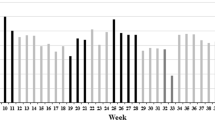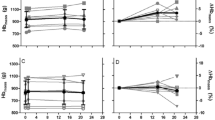Abstract
Studies performed over the past decade have yielded new information related to the physiological and metabolic adjustments made in response to both shortand long-term high-altitude exposure. These investigations have examined the potential mechanisms responsible for the alterations observed in such key variables as heart rate, stroke volume, cardiac output, muscle blood flow, substrate utilization and mitochondrial function, both at rest and during exercise of varying intensities. Additionally, the occurrence and mechanisms related to the ‘lactate paradox’ continues to intrigue investigators. It is apparent that exposure to high altitude is an environmental stressor that elicits a robust sympathoadrenal response that contributes to many of the critical adjustments and adaptations mentioned above. Furthermore, as some of these important physiological adaptations are known to enhance performance, it has become popular to incorporate an aspect of altitude living/training into the training regimens of endurance athletes (e.g. ‘live high-train low’). Finally, it is important to note that many factors influence the extent to which individuals adjust and adapt to the stress imposed by exposure to high altitude. Included among these are (i) the degree of hypoxia; (ii) the duration of exposure to hypoxic conditions; (iii) the exercise intensity (absolute vs relative workload); and (iv) the inter-individual variability in adapting to hypoxic environments (‘responders’ vs ‘non-responders’).




Similar content being viewed by others
References
Mazzeo RS, Bender PR, Brooks GA, et al. Arterial catecholamine responses during exercise with acute and chronic high altitude exposure. Am J Physiol 1991; 261: E419–24
Mazzeo RS, Brooks GA, Butterfield GE, et al. Acclimatization to high altitude increases muscle sympathetic activity both at rest and during exercise. Am J Physiol 1995; 269: R201–7
Wolfel EE, Groves BM, Brooks GA, et al. Oxygen transport during steady-state submaximal exercise in chronic hypoxia. J Appl Physiol 1991; 70: 1129–36
Wolfel EE, Selland MA, Cymerman A, et al. O2 extraction maintains O2 uptake during submaximal exercise with ß-adrenergic blockade at 4,300 m. J Appl Physiol 1998; 85: 1092–102
Hansen J, Sanders M. Sympathetic neural overactivity in healthy humans after prolonged exposure to hypobaric hypoxia. J Physiol 2003; 546: 921–9
Hopkins SR, Bogaard HJ, Niizeki K, et al. ß-Adrenergic or parasympathetic inhibition, heart rate, and cardiac output during normoxic and acute hypoxic exercise in humans. J Physiol 2003; 550 (2): 605–15
Mazzeo RS, Wolfel EE, Butterfield GE, et al. Sympathetic responses during 21 days at high altitude (4,300 m) as determined by urinary and arterial catecholamines. Metabolism 1994; 43: 1226–32
Cornolo J, Mollard P, Brugniaux JV, et al. Autonomic control of the cardiovascular system during acclimatization to high altitude: effects of sildenafil. J Appl Physiol 2004; 97: 935–40
Hughson RL, Yamamoto Y, McCullough RE, et al. Sympathetic and parasympathetic indicators of heart rate control at altitude studied by spectral analysis. J Appl Physiol 1994; 77: 2537–42
Grover RF, Weil JV, Reeves JT. Cardiovascular adaptation to exercise at high altitude. Exerc Sport Sci Rev 1986; 14: 269–302
Reeves JT, Groves BM, Sutton JR, et al. OEII: preservation of cardiac function at extreme altitude. J Appl Physiol 1987; 63: 531–9
Calbet JA, Boushel R, Radegran G, et al. Why is. Am J Physiol Regul Integr Comp Physiol 2003; 284 (2): R304–16
Lundby C, Sander M, van Hall G, et al. Maximal exercise and muscle oxygen extraction in acclimatizing lowlanders and high altitude natives. J Physiol 2006; 573 (2): 535–47
Roach RC, Koskolou MD, Calbet JA, et al. Arterial O. Am J Physiol 1999; 276 (2 Pt 2): H438–45
Richalet JP, Larmignat P, Rathat C, et al. Decreased human cardiac response to isoproterenol infusion in acute and chronic hypoxia. J Appl Physiol 1998; 65: 1957–61
Wagner PD. Reduced maximal cardiac output at altitude: mechanisms and significance. Respir Physiol 2000; 120: 1–11
Calbet JA, Radegran G, Boushel R, et al. Plasma volume expansion does not increase maximal cardiac output or V? O2max in lowlanders acclimatized to altitude. Am J Physiol 2004; 287: H1214–24
Bender PR, Groves BM, McCullough RE, et al. Oxygen transport to exercising leg in chronic hypoxia. J Appl Physiol 1988; 65: 2592–7
Braun B, Mawson JT, Muza SR, et al. Women at altitude: carbohydrate utilization during exercise at 4300 m. J Appl Physiol 2000; 88: 246–56
Brooks GA, Butterfield GE, Wolfe RR, et al. Decreased reliance on lactate during exercise after acclimatization to 4,300 m. J Appl Physiol 1991; 71: 333–41
Brooks GA, Wolfel EE, Groves BM, et al. Muscle accounts for glucose disposal but not blood lactate appearance during exercise after acclimatization to 4,300 m. J Appl Physiol 1992; 72: 2435–45
Roberts AC, Reeves JT, Butterfield GE, et al. Altitude and ß-blockade augment glucose utilization during submaximal exercise. J Appl Physiol 1996; 80: 605–15
Lundby C, Van Hall G. Substrate utilization in sea level residents during exercise in acute hypoxia and after 4 weeks ofacclimatization to 4100 m. Acta Physiol Scand 2002; 176: 195–201
Brooks GA, Mercier J. The balance of carbohydrate and lipid utilization during exercise: the crossover concept. J ApplPhysiol 1994; 76: 2253–61
Romijn JA, Coyle EF, Sidossis S, et al. Regulation of endogenous fat and carbohydrate metabolism in relation to exercise intensity and duration. Am J Physiol 1993; 265: E380–91
Butterfield GE, Gates J, Fleming S, et al. Increased energy intake minimizes weight loss in men at high altitude. J Appl Physiol 1992; 72: 1741–8
Cartee GD, Douen AG, Ramlal T, et al. Stimulation of glucose transport in skeletal muscle by hypoxia. J Appl Physiol 1991; 70: 1593–600
Tarnopolsky LJ, MacDougall JD, Atkinson SA, et al. Gender differences in substrate for endurance exercise. J Appl Physiol 1990; 68: 302–8
Kayser B. Lactate during exercise at high altitude. Eur J Appl Physiol 1996; 74: 195–205
Mazzeo RS, Brooks GA, Butterfield GE, et al. ß-Adrenergic blockade does not prevent the lactate response to exercise after acclimatization to high altitude. J Appl Physiol 1994; 76: 610–5
Pronk M, Tiemessen I, Hupperets MD, et al. Persistence of the lactate paradox over 8 weeks at 3,8000 m. High Alt Med Biol 2003; 4: 431–43
Hochachka PW, Beatty CL, Burelle Y, et al. The lactate paradox in human high-altitude performance. News Physiol Sci 2002; 17: 122–6
Van Hall G, Calbet JAL, SØndergaard H, et al. The re-establishment of the normal blood lactate response to exercise in humans after prolonged acclimatization to altitude. J Physiol 2001; 563: 963–75
Van Hall G. Point: the lactate paradox does not occur during exercise at high altitude. J Appl Physiol 2007; 102 (6): 2399–401
West J. Point: the lactate paradox does occur during exercise at high altitude. J Appl Physiol 2007; 102 (6): 2398–9
Levine BD, Stray-Gundersen J. “Living high-training low”: effect of moderate-altitude acclimatization with low-altitude training on performance. J Appl Physiol 1997; 83 (1): 102–12
Levine BD, Stray-Gundersen J. A practical approach to altitude training: where to live and train for optimal performance enhancement. Int J Sports Med 1992; 13: S209–12
Stray-Gundersen J, Chapman RF, Levine BD. ‘Living high-training low’ altitude training improves sea level performance in male and female elite runners. J Appl Physiol 2001; 91: 1113–20
Brugniaux JV, Schmitt L, Robach P, et al. Eighteen days of ‘living high, training low’ stimulate erythropoiesis and enhance aerobic performance in elite middle-distance runners. J Appl Phsyiol 2006; 100: 203–11
Levine BD, Stray-Gundersen J. Point: positive effects of intermittent hypoxia (live high:train low) on exercise performance are mediated primarily by augmented red cell volume. J Appl Physiol 2005; 99: 2053–5
Robach P, Schmitt L, Brugniaux JV, et al. Living high-training low: effect on erythropoiesis and aerobic performance in high-ly-trained swimmers. Eur J Appl Physiol 2006; 96: 423–33
Gore CJ, Hopkins WG. Counterpoint: positive effects of intermittent hypoxia (live high:train low) on exercise performance are not mediated primarily by augmented red cell volume. J Appl Physiol 2005; 99: 2055–7
Schmitt L, Millet G, Robach P, et al. Influence of ‘living high-training low’ on aerobic performance and economy of work in elite athletes. Eur J Appl Physiol 2006; 97: 627–36
Author information
Authors and Affiliations
Corresponding author
Rights and permissions
About this article
Cite this article
Mazzeo, R.S. Physiological Responses to Exercise at Altitude. Sports Med 38, 1–8 (2008). https://doi.org/10.2165/00007256-200838010-00001
Published:
Issue Date:
DOI: https://doi.org/10.2165/00007256-200838010-00001




